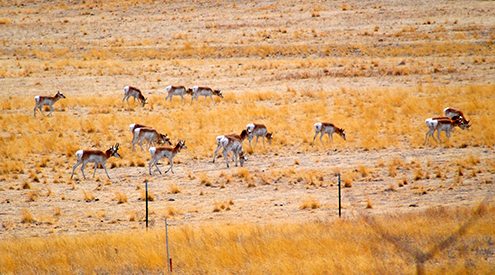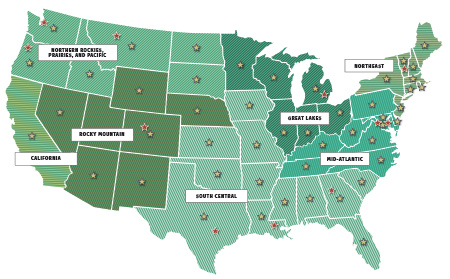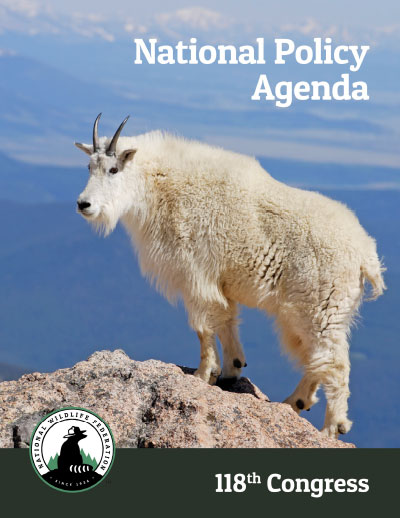
The National Wildlife Federation and its 52 state and territorial affiliates are committed to uniting people from all walks of life and giving wildlife a voice in the halls of Congress. For more than eight decades, the Federation has served as a trusted advocate, working to conserve wildlife, watersheds, and landscapes for future generations and to ensure wildlife thrive in a rapidly changing climate.
Today, more than a third of our country’s species are at risk of extinction in the coming decades. In the last 20 years, monarch butterfly populations have experienced declines by as much as 90 percent. America’s free-ranging bison, which once numbered 20 to 30 million, are down to fewer than 30,000. In the face of these challenges, the National Wildlife Federation remains at the forefront of the fight to tackle wildlife’s greatest threats, working collaboratively to increase wildlife populations and enhance their capacity to thrive.
The 118th Congress has the opportunity to enact meaningful legislation to restore wildlife habitat, improve climate resilience, and expand equitable solutions for frontline communities. The National Wildlife Federation encourages members to pursue lasting, bipartisan solutions like the Recovering America’s Wildlife Act that benefit people and wildlife alike.
Historic Wins in the 117th Congress
The 117th Congress passed significant legislation that seeks to tackle the climate and biodiversity crises by investing in wildlife, our lands and waters, communities, and clean energy solutions.
The Inflation Reduction Act puts our nation on the path to a clean energy future by reducing pollution, creating good-paying jobs, and achieving energy independence. This bill also contains critical investments in natural infrastructure, advancing the Federation’s longstanding efforts to enhance resilience and nature-based climate solutions.
The bipartisan Infrastructure Investment and Jobs Act will not only improve bridges, roads, and public transportation, it will also deliver clean drinking water, restore fish and wildlife habitat, fund wildlife crossings, reclaim degraded lands, and boost clean energy innovation.
The CHIPS and Science Act – also bipartisan – includes investments in science and technology that will drive advances in clean energy and other sectors to make a zero-carbon future possible.
Bipartisan passage of the Chronic Wasting Disease Research and Management Act invests in research to detect and manage this fatal disease threatening deer, moose, and elk and funds state and Tribal agencies to assist in the work to stop its spread. The Safeguarding Treatment for the Restoration of Ecosystems from Abandoned Mines (STREAM) Act, which also passed in the final days of the 117th Congress, authorizes states to set aside up to 30 percent of their annual bipartisan infrastructure law abandoned mine land grant into an account for the treatment and abatement of acid mine drainage.
Now it’s time to ensure that these and other notable achievements are quickly and effectively implemented to benefit all communities. Congress must also build on this strong foundation to create a more equitable future for wildlife and people alike. Here, we outline the legislative and administrative priorities that the National Wildlife Federation will pursue in the 118th Congress to ensure a better future for all.
The Recovering America’s Wildlife Act
One-third of all U.S. wildlife species currently face an elevated risk of extinction because of threats like habitat loss, climate change, invasive species, and emerging diseases. More than 150 U.S. species have already gone extinct, and nearly 500 additional species have not been seen in decades and may be extinct. One-third of bird species and 40 percent of freshwater fish species are in need of urgent conservation action. Right now, we are in a race against time to avert a looming wildlife extinction crisis. Unless we change course, we risk losing our nation’s treasured wildlife – from backyard birds to bighorn sheep. In addition to depriving future generations of the beautiful diversity of wildlife in this country, this loss will harm local and regional economies in innumerable ways.
The bipartisan Recovering America’s Wildlife Act will allow states, territories, and Tribes to invest $1.4 billion annually in proactive, on-the ground, collaborative efforts to help at-risk species by restoring habitat, controlling invasive species, reconnecting migration routes, and addressing emerging diseases. This common-sense legislation will enable state and Tribal wildlife agencies to implement their unique congressionally-mandated wildlife action plans. These detailed plans incorporate the best-available science and broad public input and have been approved by the U.S. Fish and Wildlife Service. Collectively, these plans identify more than 12,000 species of plants and animals in need of assistance. Currently, the federal government provides less than five percent of what would be needed to implement these plans in a meaningful way.
Proactive measures taken earlier in a species’ decline are cheaper and more effective than waiting until the species is in need of listing under the Endangered Species Act. We have no time to waste. We know that increasing funding for conservation efforts works. State, Tribal, and federal wildlife agencies have had great success in restoring other species that were once on the brink – like bald eagles, peregrine falcons, white-tailed deer, elk, striped bass and more. Thanks to dedicated funding, these fish and wildlife now have healthy and thriving numbers.
When we save wildlife, we save ourselves. Healthy fish and wildlife populations and resilient habitats contribute to clean water and air, flood prevention, pollination, and carbon sequestration, and they represent the heart of our nation’s outdoor heritage. The Recovering America’s Wildlife Act will also result in more recreational opportunities for all Americans, which will create jobs as Americans spend $140 billion every year on wildlife-focused recreation alone.
Restoring Working Lands
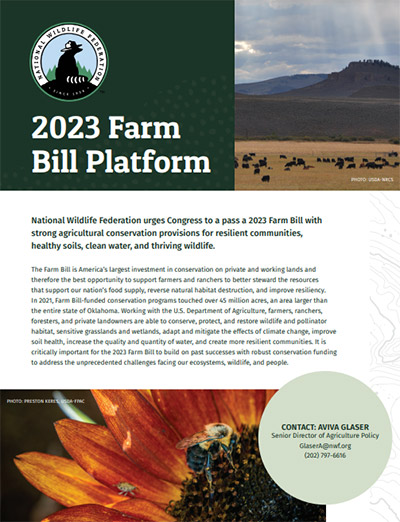
Working landscapes provide critical wildlife habitat, water quality functions, and carbon sequestration, as well as hunting, fishing, and outdoor recreation opportunities. Congress should pass a 2023 Farm Bill with strong, well-funded conservation programs and provisions that enable farmers, ranchers, and foresters to adopt practices that restore habitat for wildlife, improve water quality and quantity, and build soil health. To achieve these goals, the 2023 Farm Bill should:
- Increase conservation title funding to meet producer demand and protect and build on the conservation funding provided in the Inflation Reduction Act.
- Prevent the conversion of native prairies to cropland and save taxpayer dollars through a nationwide Sodsaver provision.
- Improve equity in the delivery of technical and financial assistance from conservation programs.
- Maximize conservation program benefits to wildlife, climate, and water.
- Support diversified cropping systems, advanced grazing methods, and practices that improve wildlife connectivity.
- Enhance the U.S. Department of Agriculture’s (USDA) data collection, measurement, and analysis systems, including support for robust forest carbon measurement, to improve program delivery and technical assistance.
- Provide funding for tree planting, agroforestry, and forest stewardship that is ecologically appropriate, does not undermine grassland conservation, and includes a forest stewardship plan, as applicable.
- Ensure that programs for climate-smart forestry and agriculture deliver real, measurable benefits based on evaluation and the best available evidence.
Despite recent progress made on equity at USDA, major improvements are needed to ensure that all producers, regardless of race, gender, experience, or scale have equitable access to agriculture conservation tools. The legacy of discrimination against historically underserved farmers and ranchers, which includes Black, Native American, Hispanic, and other minority groups, has led to a massive decline in their land ownership and forced many out of farming and ranching altogether. The 2023 Farm Bill should make reforms within USDA to prevent discrimination and ensure access to farm programs that keep farmers on their land. The bill should help to resolve heirs’ property issues, support access to credit and programs, and invest in equitable technical assistance agreements with trusted partners who have a history of working with historically underserved farmers and ranchers. In addition, it should bolster the resources that land grant universities, Historically Black Colleges and Universities (HBCUs), Hispanic-serving institutions, and Tribal organizations can use to partner with producers, USDA, and non-profits to bolster a new generation working the land and creating resilient communities.
Private landowners play an essential role in conserving unique ecosystems on the lands and waters in their trust, improving resilience in the face of a changing climate, connecting fragmented landscapes, and restoring habitat. As we work to identify and conserve lands of particularly high conservation value, the National Wildlife Federation encourages Congress to create new tools to support private landowners’ ability to afford and pay for restoration and conservation of land in their trust. This may include reviewing existing incentives and subsidies, expansion of access to existing programs, and developing new programs to support private land conservation.
Creating new tax credits and incentives to conserve wildlife and their habitat will build upon existing federal and state-oriented conservation programs to activate the vast network of private landowners who are eager to safeguard the landscapes in their care. The Federation encourages Congress to pursue new ways of pairing federal tax breaks to support conservation and activate the power of private enterprise in this important work.
One such proposal is a new tax credit for carbon storage in agriculture, grassland, and forest ecosystems, similar to the existing tax credit for direct air capture, to help incentivize the development and expansion of natural climate solutions. As Congress considers new private land conservation tools, equity and justice principles should be centered, in order to avoid further disenfranchisement of communities historically unable to access tax credits and public funding to conserve their land.
Promoting Environmental Justice and Healthy Communities
Lower wealth frontline communities have historically borne the brunt of pollution in this nation. Without proper attention and investment, we expect that the worst effects of climate change will continue to fall hardest on communities that have the fewest resources to cope with them.
Congress should strengthen legislation and increase investments into communities that have experienced socio-economic disparities, environmental racism, and other forms of injustice. Both the White House and Congress must collaborate with local communities to ensure that all climate policies support workers, revive depressed economies, build resilience, and reduce pollution. These priorities are reflected throughout the breadth of the Federation’s work, but there are some specific priorities worth noting.
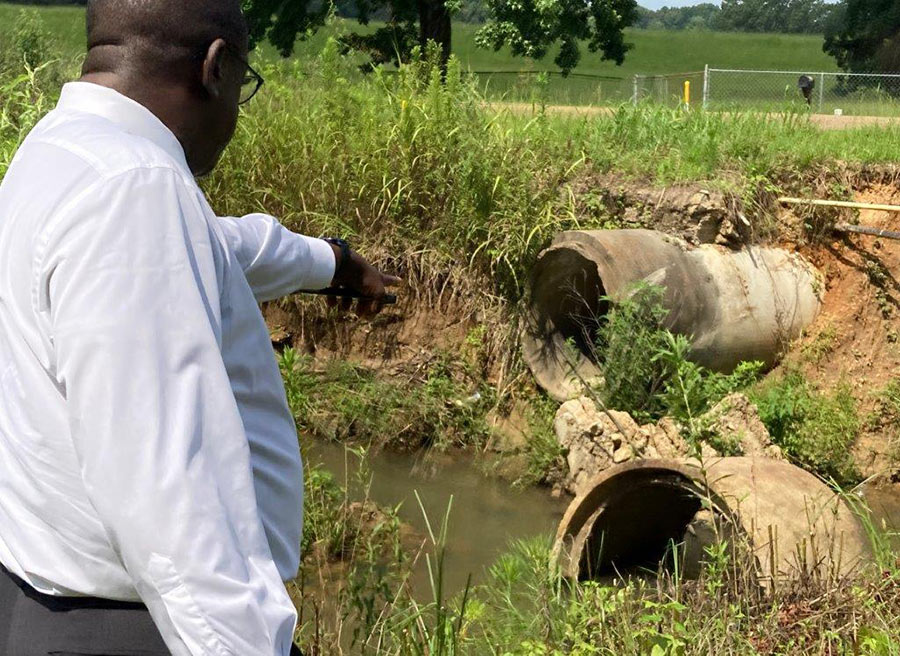
Photo Credit: National WIldlife Federation
The Inflation Reduction Act and the Infrastructure Investment and Jobs Act took meaningful steps to provide a cleaner future for frontline communities, but there is more to be done. We must stay vigilant to prevent the creation of new sacrifice zones as these laws are implemented. Provisions that require our attention include: the Inflation Reduction Act’s mandate of additional oil and gas development in the Gulf of Mexico and Alaska’s Cook Inlet, and its requirement for new oil and gas leasing on public lands in order for new wind and solar projects to be approved. We look forward to working with Congress to strengthen regulatory policies to ensure that climate-related actions are carried out in a sustainable manner while preventing unintended harms or negative impacts to affected communities. Key regulatory priorities for 2023 include National Ambient Air Quality Standards (NAAQS) for Particulate Matter (Soot Rule), Mercury and Air Toxics Standards (MACT), NAAQS for Ozone (Smog Rule), and Direct Air Capture Hubs, among others.
The National Wildlife Federation is working with Congress and the Administration to ensure that climate and environmental solutions don’t add to or perpetuate injustices borne by frontline communities. We believe that to effectively address climate change we must address race and class disparities in exposure to pollution, deteriorating infrastructure, health inequities, and more. We must work with, and center, the voices and lived experiences of historically marginalized people when crafting climate mitigation and adaptation strategies.
To aid accountability, we look forward to further supporting the development of the Climate and Economic Justice Screening Tool to ensure that existing policies and targeted investments can address frontline community needs.
Through our Tribal Partnerships Program, the National Wildlife Federation collaborates with sovereign Tribal nations and Indigenous Peoples to solve today’s conservation challenges for future generations. We work nationwide with Tribes to restore wildlife, advance land stewardship, safeguard water resources, support culturally-appropriate environmental education, and address climate change.
The Tribal Partnerships Program is guided by the vision that Sovereign Tribal governments have the capacity and influence to achieve their natural resource goals and better address associated socio-economic and environmental justice issues. Along with our Tribal partners, we work to address historical injustices through the advancement of new policy that leads to increased resources and capacity for Tribes to address wildlife and habitat conservation priorities while sustaining their cultural values.
Additional priorities for the 118th Congress include passing the Recovering America’s Wildlife Act, which would invest $97 million annually in conservation work led by the 574 federally-recognized Tribes, as well as approving the Indian Buffalo Management Act and Tribal Wildlife Corridors Act; promoting greater inclusion of and collaboration with Tribes in Department of the Interior wildlife connectivity programs; increasing and directing appropriations for Tribal conservation goals; and corresponding implementation and advancement of Tribal priorities in the Joint Interior and Agriculture Secretarial Order on Fulfilling the Trust Responsibility to Indian Tribes in the Stewardship of Federal Lands and Waters as well as the Department of the Interior’s Bison Initiative.

The Tribal Access to Clean Water Act complements funding in the Infrastructure Investment and Jobs Act by providing additional funding for water infrastructure for Tribes and Indigenous communities. Investments from the IIJA made available funds for physical infrastructure upgrades to Tribal water systems. The Tribal Access to Clean Water Act would add additional support for the human component of Tribal water and sanitation services, address water-related health risks, and keep water and sewer systems operating in good condition into the future.
Photo Credit: Ted Wood
Transitioning to a Clean Energy Economy
The Inflation Reduction Act’s historic investments in clean energy have already begun fueling the groundbreaking projects we need to build a climate-smart energy grid. But we can bring new clean energy sources online more quickly by supporting transmission projects and policies that move energy from new, clean generation sources to the homes, businesses, and vehicles where it is needed.
The Inflation Reduction Act provided nearly $700 million to support National Environmental Policy Act (NEPA) reviews across federal agencies, but the 118th Congress can take more steps to bolster the Federal Energy Regulatory Commission’s (FERC’s) ability to enhance planning and coordination between states and regions. Action could include:
- Additional financing for transmission construction, such as an investment tax credit;
- Additional funding for environmental review and stakeholder/community engagement;
- Providing FERC (or the Department of Energy) enhanced authority to facilitate interstate transmission projects and coordinate project reviews; and
- Enhancing interregional coordination and designation of corridors.
However, as Congress and the Administration consider permitting decisions for major energy infrastructure, it is imperative that we not repeat the same mistakes that have divided marginalized communities and exposed them to pollution at disproportionately higher rates. Discussion of changes to the permitting process for energy projects must include the input of the communities who will live with those projects’ impact.
The A. Donald McEachin Environmental Justice for All Act would provide long overdue, essential protections to combat the disproportionate burden Black, Indigenous, and other communities of color have faced due to toxic pollution. This bill would strengthen key legislation such as Title VI of the Civil Rights Act of 1964 and the National Environmental Policy Act. The bill was developed in a collaborative process with many frontline communities through a series of roundtables convened by the House Natural Resources Committee.
Responsible development of offshore wind energy offers an untapped opportunity to harness abundant clean energy in close proximity to some of the largest energy markets. With coastal states continuing to increase their ambition on offshore wind (OSW) production targets and the Administration moving aggressively to open new areas for development, it is critical that this ambition is matched with stringent measures to avoid, minimize, mitigate, and monitor impacts on wildlife and habitat every step of the way. The time is ripe for Congress to follow up on the investments made in the Inflation Reduction Act to further bolster the industry and ensure a thriving domestic supply chain, and to ensure robust appropriations to the Bureau of Ocean Energy Management (BOEM) and the National Oceanic and Atmospheric Administration (NOAA) to support the review, research, and monitoring needs of advancing OSW responsibly. Legislative needs include:
- Changes to the Outer Continental Shelf Lands Act (OCSLA) to better incorporate offshore wind;
- Funding to jump-start workforce training and domestic ship-building capabilities to support manufacturing and transport of offshore wind equipment; and
- Passage of the Reinvesting In Shoreline Economies and Ecosystems Act (RISEE Act) to support funding for critical research, ocean and coastal restoration, and resilience of coastal communities around the nation.
The 117th Congress made historic investments in carbon management, including the technologies and strategies that pull excess carbon dioxide directly out of the air and capture it at a point source. Yet there is a need for more action to fully enable emerging technologies to succeed, to revitalize clean energy manufacturing and related technologies, and for further investment in natural carbon dioxide removal that offers ecological benefits alongside immediate, economical climate mitigation. Legislative priorities include:
- Funding for research, demonstration, and deployment of both technological and natural carbon management strategies;
- Expanding the 45Q tax credit or creating a new tax credit for pathways beyond direct air capture; and
- Imposing a carbon border adjustment fee on energy-intensive imports to internalize costs associated with higher carbon intensity abroad, while incentivizing decarbonization of American manufacturing.
Safeguarding Access to Clean Water
Access to clean, safe water for drinking, fishing, and swimming is a fundamental human right. The Clean Water Act is the most important federal law protecting water quality, reducing pollution, and ensuring clean water for wildlife and communities alike. It is responsible for the fact that our waters are no longer on fire or used as open sewers—real conditions that led to the act’s sweeping, bipartisan passage fifty years ago.
Early in the 118th Congress, the Supreme Court will rule on a case called Sackett v. EPA that could remove long-standing Clean Water Act protections for roughly half the nation’s streams and wetlands, undermining the careful balancing of state and federal responsibilities in administering the law. This decision could cripple the Clean Water Act and prevent the Environmental Protection Agency (EPA) from issuing updated rules, currently in the works, that would use science to clarify these protections for important streams and wetlands. If that happens, it will be up to Congress to fix the damage done. Regardless of the Court’s decision, it is imperative that Congress reject any legislative efforts to weaken the Clean Water Act and instead support legislation that clarifies EPA’s longstanding obligation to protect our nation’s waters, from the smallest headwaters and streams to the largest rivers and bays.
The EPA estimates that we need to invest over $740 billion in maintaining and repairing our wastewater and drinking water infrastructure over twenty years just to meet environmental and public health standards. Climate change exacerbates existing water infrastructure challenges, which are often disproportionately borne by low-income communities, communities of color, and Indigenous Peoples. That’s why Congress should build upon the historic investments of the Infrastructure Investment and Jobs Act by further increasing annual funding levels for the Clean Water and Drinking Water State Revolving Funds (SRFs) up to at least $7.6 billion annually, including additional assistance in the form of grants, and prioritizing the use of green infrastructure approaches.
Congress must also invest in other critical federal programs that equip communities with resources to address increasing water-related challenges on a local and watershed-wide scale, including programs that repair and upgrade wastewater and stormwater infrastructure, assist households struggling to afford water bills, strengthen the resiliency of water systems, support enforcement and permitting requirements, and strengthen nutrient pollution cleanup, remediation, and reduction efforts. And this federal funding must be directed to frontline communities that need it most.
PFAS, a family of per- and polyfluoroalkyl substances, are found in numerous consumer products and packaging. These “forever chemicals” persist in people’s bodies and the environment and are linked to cancers and immune disorders in people and reduced reproductive success in wildlife.
The National Wildlife Federation supports federal drinking water standards, hazardous substance declaration for PFAS, and using Clean Water Act tools to address PFAS in our waters, whether through legislative action like the PFAS Action Act or administrative rulemaking. The Federation is also exploring options to reduce exposures on contaminated land and better understand these chemicals’ impact on wildlife, especially in game species consumed by hunters, anglers, and their families.
Promoting Landscape-Scale Conservation
North America’s grasslands – ranging from iconic tallgrass prairies, to coastal glades and savannahs, to native meadows and high mountain steppe – are disappearing at an accelerating pace. Grassland ecosystems are foundational habitats for species across the nation and a major carbon sink.
One of the most imperiled grasslands, the sagebrush steppe, is one of the largest ecosystems in North America. Millions of acres are degraded every year due to invasive species, fire, conversion to cropland, subdivision, and industrial development. Over 350 species of wildlife and plants rely on this landscape—including sage grouse, mule deer, pronghorn, bighorn sheep, and other iconic species. The 117th Congress made a significant financial investment in tackling the threats to the sagebrush ecosystem but it remains at risk. Congress must act with haste to curb their loss and to support voluntary, landowner-driven efforts to restore and replace grasslands, and to increase funding to combat invasive grasses, for the prevention and mitigation of damaging fires, and to rehabilitate watersheds.
The Federation and partner organizations from across the conservation community – including farmers, ranchers, hunters, birders, wildlife biologists, and conservation professionals – are advocating for Congress to quickly pass the North American Grasslands Conservation Act. This bill provides both a framework and funding to enable voluntary partnerships with landowners to conserve and restore America’s grasslands, and it is built upon the proven, collaborative model of the North American Wetlands Conservation Act.

Photo Credit: Aaron Kindle
Healthy forests on private and public lands provide irreplaceable environmental, social, and economic benefits to communities and provide wildlife with essential habitat.
Congress must ensure that efforts to harness the climate-mitigating power of forests are guided by the best available science and consider multiple impacts. It should begin to phase out large-scale bioenergy generation and wood pellet production for electricity generation, which pose clear threats to communities and to the climate. As a first step, Congress should ensure that appropriations bills do not include riders that seek to legislate the carbon neutrality of bioenergy.
National forests in the West have suffered for decades from increasing fire frequency and intensity, and a devastating pine beetle epidemic. Fire suppression, questionable management practices, and extreme drought have exacerbated these problems. Congress made significant investments in forest restoration during the 117th Congress and should build on that momentum by investing in fire management and mitigation, landscape connectivity, and general support for healthy forests that can benefit wildlife, watersheds, and the people that depend on both.
Overall, Congress should continue to build off the historic investments in public and private forests, catalyzing climate-smart forest stewardship and innovative conservation tools that allow both biodiversity and local communities to thrive.
The Great Lakes encompass 95% of North America’s freshwater, and over 40 million people rely on them for drinking water. They are foundational to the region’s economy and way of life.
From the Great Lakes to the Chesapeake Bay to the Everglades, America’s great watersheds help define us as a nation, providing fishing and boating opportunities, drinking water, and incredible wildlife habitat—and they need more attention than ever in the face of a changing climate.
Congress should build on the ecosystem restoration investments made through the Infrastructure Investment and Jobs Act and provide ongoing robust federal funding for critical EPA, Army Corps, and Department of the Interior ecosystem restoration and pollution reduction programs that support large-scale restoration efforts across the country, including in the Great Lakes, Mississippi River Delta, and Chesapeake Bay, as well as the Delaware River Basin, where the Delaware River Basin Conservation Act will require reauthorization during the 118th Congress. The federal government should fund Everglades restoration efforts at $725 million annually to accelerate the ecosystem benefits of restoration, building on recent historic federal and state investments to get projects across the finish line.
Additionally, new regional restoration and resilience efforts should be established and resourced along the mainstem of the Mississippi River, and in the 14-state Ohio River Basin.
Research shows that conserving existing natural coastal features like marshes is one of the most effective ways to store carbon. Congress should strive to protect taxpayers and the environment by reducing incentives for risky development in floodplains and along our coastlines, including through improvements to the Coastal Barrier Resources Act and efforts to advance coastal blue carbon solutions.
Congress should also work to ensure a sustainable source of funding for coastal states to confront the unique stressors of rapidly rising sea levels and increased coastal storms, including through passage of the Reinvesting in America’s Shoreline Economies and Ecosystems Act, which establishes a new revenue sharing program for offshore wind.
The National Oceanic and Atmospheric Administration (NOAA) also has a critical role to play in promoting climate resilience along our coastlines and supporting climate science. Robust appropriations for NOAA programs, including those within the National Ocean Service and National Marine Fisheries Service, are critical to protect our coasts and ocean environments.
As we work to conserve special offshore places to maximize their benefits for people and wildlife, it is also critical that Congress increase the resources available for the National Marine Sanctuary System. Protecting highly imperiled marine life should remain a priority for Congress, including increased funding for grants supporting innovative fishing strategies that help both the declining population of the North Atlantic Right Whale and the communities and fishermen impacted by efforts to restore it. Congress should also act to support marine ecosystem health by improving protection of forage fish—species that constitute the foundation of ocean food webs—through passage of the Forage Fish Conservation Act.
Natural infrastructure—including healthy rivers, wetlands, and floodplains-provides important fish and wildlife habitat, clean water, and extensive economic opportunities. Natural infrastructure is also a cost-effective way to help communities to reduce the impacts of more frequent and intense storms, floods, droughts, rapidly rising sea levels, and the unintended consequences of many already-constructed water resources projects. It is critical that we harness the full potential of natural infrastructure to increase the ability of our communities and wildlife to adapt and thrive as we face a changing climate.
Water resources projects carried out by the Army Corps of Engineers have an outsized impact on the nation’s rivers, wetlands, wildlife, and communities. To help wildlife and communities thrive, Congress should ensure that the next Water Resources Development Act (WRDA) builds on recent positive steps to maximize the use of natural infrastructure and infuse community and ecosystem resilience into all Army Corps projects. Congress should also provide strong oversight of the Army Corps’ implementation of recent WRDA provisions that advance the use of natural infrastructure for flood protection, improve Corps engagement with economically disadvantaged communities and Tribal Nations, and modernize Corps planning. Importantly, as part of required ongoing updates to its planning guidelines, the Army Corps should adopt a modern project planning paradigm that prioritizes natural infrastructure and other resilient solutions and fully accounts for losses and gains in the many services provided by healthy ecosystems.
Flooding is one of the most expensive types of natural disasters in the United States, costing taxpayers billions of dollars each year in property losses on top of untold suffering. After repeated short-term extensions of the National Flood Insurance Program (NFIP), Congress should act to fully reauthorize and reform the NFIP. Reauthorization should require the Federal Emergency Management Agency (FEMA) to increase the pace and accuracy of flood map updates using the most modern science and technology, thoroughly integrate future climate change risks, encourage pre-disaster mitigation prioritizing natural infrastructure to reduce risk, and support Risk Rating 2.0 as a continued glidepath toward risk-based premiums, with means-tested assistance for those who cannot afford actuarial rates.
Congress should also pursue reforms under the Stafford Act to encourage FEMA to prioritize and advance nature-based hazard mitigation projects, and to improve equitable delivery of pre- and post-disaster support, including through additional capacity-building and technical assistance access and funding across all communities.
Cleaning Up Degraded Lands
Historic funding from the 117th Congress for degraded land reclamation will improve the health, environment, and economy of communities across the U.S. – particularly disenfranchised, rural, and fossil fuel-intensive communities. Additional policies and investments are needed to help these places build inclusive economies, sequester carbon, and remove ongoing threats to people and wildlife. Legislative priorities include:
- Funding for reclamation for modern-era (post-1977) mine lands;
- Additional research and analysis of the carbon sequestration and climate resilience potential from restoration of degraded lands;
- Establishment of a national abandoned hardrock mine clean-up program paid for by industry fees.
As we restore degraded lands, we should also ensure that continued development on our public lands is done responsibly, so that cleanup costs in the future don’t fall on the public. Congress should prioritize bonding reform to make sure that companies developing oil and gas wells on public lands, not the public itself, are responsible for paying for full plugging and reclamation.
The Good Samaritan Remediation of Abandoned Hardrock Mines Act encourages the cleanup of abandoned hardrock mines for the benefit of wildlife, public lands and waters, local communities and outdoor recreation. This bill removes the barriers that prevent “good Samaritan” organizations from taking on the task of cleaning up and improving water quality in and around abandoned hard rock mines.
Conserving Public Lands
The federal government holds more than 640 million acres of land and water in the public trust for the benefit of everyone. These lands provide clean drinking water to tens of millions of Americans. They provide habitat for fish and wildlife, naturally sequester carbon, and are sources of natural resources and recreation opportunities for all. Public lands provide solace, connection to nature, and sustenance for so many.
We have a moral obligation to leave a healthy, sustainable environment for future generations. Doing so requires conserving our most iconic landscapes, which is why the National Wildlife Federation supports legislation such as the CORE Act, the Grand Canyon Protection Act, and efforts to safeguard Chaco Canyon in New Mexico, and the Desert National Wildlife Refuge in Nevada. It also requires restoring degraded ecosystems and watersheds, and ensuring the biological integrity of our public lands. Throughout this endeavor, we must ensure equitable access to nature, and the safety and well-being of frontline communities and individuals from all walks of life.
Unfortunately, lands and cultural resources across the West are increasingly vulnerable to vandalism, theft, and illegal dumping. Congress must provide the federal agencies with the resources to protect special places—like the highest concentration of petroglyphs anywhere in the United States found in the Caja del Rio of Northern New Mexico.
The public’s ability to access land, water, and wildlife is under constant threat. Whether it be access conflicts in checkerboard landscapes of Montana, Nevada, and Wyoming; threats to accessing waterways in New Mexico, Montana, and Utah; or attempts to privatize wildlife throughout the country, access to public trust resources is too often limited to those with the deepest pockets. The Administration and Congress should pursue programs and policies that ensure everyone—regardless of race or socioeconomic status—has equal access to our public trust resources.
Hunters and anglers are some of the nation’s most ardent conservationists, since they see first-hand the threats to lands, water, and habitats. By safeguarding sporting traditions and laws like the Pittman-Robertson and Dingell-Johnson Acts, Congress can ensure that hunters and anglers can continue to be stewards of the land for future generations.
Additionally, Congress should increase funding for National Wildlife Refuges, the nation’s only federal public lands devoted to the needs of wildlife, which are severely underfunded and understaffed. Specifically, the National Wildlife Federation encourages Congress to increase funding for Refuge System Operations and Maintenance, starting by providing $600 million in fiscal year 2024.
The 2015 National Defense Authorization Act released over 2,000 acres from U.S. Forest Service control, allowing for mining companies to develop a copper mine in the Tonto National Forest and threaten the watershed and environment in this area. The Save Oak Flat Act would repeal the release of this area and permanently protect the Chi-chil Bildagoteel or Oak Flat, a sacred site for the San Carlos Apache Tribe and other Tribal communities in the area.

Photo Credit: Mary Jo Brooks
Ensuring that Wildlife Thrive in a Changing World
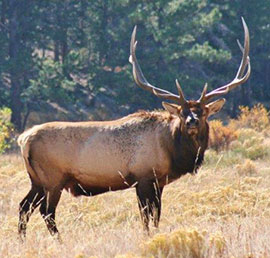
The National Wildlife Federation commends Congress for the significant and bipartisan steps it has taken to address the crises facing wildlife and biodiversity in America and abroad. Congress, with the Administration’s support, took on key aspects of the wildlife crisis by creating the first U.S. wildlife crossings program; expanding fish passage and habitat programs; addressing the threat of Chronic Wasting Disease to deer, elk, and the hunting economy; and increasing funding for public land wildlife and endangered species recovery programs. The Administration is implementing these programs, while establishing new programs to maintain wildlife movements and reestablish endangered, threatened, and depleted species.
The wildlife and biodiversity crises are complex and multifaceted, however, and have rippling effects through our economy and ecosystems. Bipartisan leadership is needed to plug remaining gaps in our conservation strategies so that the tools are in place to provide wildlife, fish, and the many people that depend on them the best opportunity to withstand current and foreseeable threats.
Photo Credit: Aaron Kindle
Fragmentation of habitat is one of the primary threats to wildlife populations. Expanding human development is cutting wildlife off from habitats they need to survive and reproduce. Climate change exacerbates this by shifting species’ ranges and degrading existing habitat.
Maintaining wildlife movements and migrations through landscapes is widely regarded as one of the most important modern conservation strategies. The 118th Congress presents an opportunity to take overdue steps and pass the first national bills to maintain wildlife movements across Tribal, private, and public lands.
Wildlife corridors are essential to maintaining healthy wildlife populations, allowing animals to migrate and move safely through the United States. The Tribal Wildlife Corridors Act would provide funding for Tribes to maintain critical wildlife movement pathways on Tribal lands. Federally recognized Tribes and Sovereign Nations have limited access to funding to carry out their conservation efforts. These grants and technical assistance would be a meaningful step to increase capacity for Tribes to adaptively manage for wildlife and habitat to improve connectivity on, through and adjacent to Tribal lands.
2023 marks the 50th anniversary of the Endangered Species Act (ESA), one of our nation’s most important and successful conservation laws. The ESA serves as a vital safety net for species, providing federal resources and expertise to help restore the most vulnerable populations of wildlife. The ESA is essential in the effort to reverse the decline of fish and wildlife and must be upheld and fully funded. In addition, more significant, reliable funding streams and clearer, science-based paths to recovery are needed to recover endangered and threatened species.
Congress should address systemic threats to wildlife such as wildlife diseases and invasive species. COVID-19, which likely transferred from wildlife to humans, highlights the need to strengthen our domestic wildlife disease response capacity and relevant international programs. The threat from wildlife diseases is greater than ever in an increasingly globalized world. Congress should increase the capacity of existing federal programs to respond to wildlife disease. Congress should also pass the Lacey Act Amendments to provide the U.S. Fish and Wildlife Service with authority to once again regulate interstate transport of diseased, invasive, and other harmful animals.
Some individual species, and groups of species, need high level, individualized effort from the Administration and Congress if they are to overcome the challenges they face.
Woodland Caribou: The only large mammal we have eliminated from the continental U.S. in modern history could eventually be restored through passage of a Woodland Caribou Conservation Act.
Wild Salmon and Steelhead: From the Pacific Coast to central Idaho, salmon and steelhead populations are integral to the identity and way of life for the Northwest’s Tribal Nations, fishermen, and Main Street businesses. These fish, however, are running out of time, and barreling towards extinction. Since the completion of the lower Snake River dams in 1975, the populations of Snake River salmon and steelhead have declined by at least 90 percent. Species, including southern resident killer whales, that rely on abundant salmon also face unprecedented challenges, and their absence could upset the regional ecosystem. The decline of salmon has also left the federal government in violation of its treaty and trust obligations to Northwest Tribes. Over the past several decades local, state, and regional leaders have tried to solve this problem to no avail, and these failures have left the region in an endless loop of litigation, division, and failed half-measures. The time has come for Congress and the Administration to put forward a comprehensive solution that invests in local communities and unites the region. With their leadership, we can achieve the largest river restoration in history, while securing a prosperous future for the Northwest by investing in reliable, affordable clean energy, local communities, and Native American Tribes.
Bison: This iconic mammal can be restored to its historic habitat on Tribal and public lands through continued implementation and funding of the Department of the Interior’s Bison Conservation Initiative.
Black-footed Ferrets: A small amount of dedicated funding will help a partnership of ranchers, Tribes, state and federal agencies, and nonprofit groups including the National Wildlife Federation finally restore this charismatic yet long-endangered species to the great plains.
Grizzly Bears: The Interior Department and state wildlife agencies are making exciting progress toward recovering grizzly bear populations in the U.S. northern Rockies and North Cascade mountains, and deserve Congressional support.
Red Wolves: Congress should support the U.S. Fish and Wildlife Service’s efforts to bring renewed energy and innovation to recover one of North America’s most endangered species.
Supporting Equitable Environmental Education
Congress has a responsibility to children, students, and workforce participants to provide opportunities that aid in the development of the knowledge and skills they will need for a more equitable, environmentally-just, and resilient future. The National Wildlife Federation works to ensure all children have access to licensed childcare and opportunities to spend quality time outdoors in a healthy manner and safe environment.
For the 118th Congress, legislative priorities include the Rebuild America’s Schools Act that will provide $130 billion in infrastructure investments to refurbish more than 30,000 K-12 schools in low-income areas that have experienced systemic racial, economic, and environmental discrimination. Related to this, we support legislative expansion of the U.S. Department of Education’s Green Ribbon Schools Program and the establishment of an Office of Facilities and Sustainability at the Education Department.
Congress also must prioritize youth workforce development, especially in frontline communities. The recently passed climate and infrastructure packages allocated significant money for capital improvements, but too little of that money went to workforce development for lower income youth of color. We support increased investments for AmeriCorps, YouthBuild, Job Corps and other youth workforce development programs. Congress should also create a 21st Century Civilian Conservation Corps (CCC) that could make giant strides in addressing the threats and racial inequities faced by communities of color while putting thousands of young Americans to work. A modernized CCC would partner with state and federal agencies, NGOs, and local partners to tackle on-the-ground projects that restore public lands and private working lands, including remediation of contamination from abandoned mines or oil and gas drilling sites.
Finally, there is an overall gap in student learning about climate mitigation, resilience, and adaptation. Just 60 percent of K-12 schools teach any climate content. Congress should pass the Climate Change Education Act that will provide $250 million for the National Oceanic and Atmospheric Administration to make grants to schools supporting climate literacy and skill development.
For more information, please contact Abby Tinsley, Vice President for Conservation Policy (TinsleyA@nwf.org), Ross Griffin, Senior Government Affairs Manager (GriffinR@nwf.org), or Natalie Hodgman, Legislative Coordinator (HodgmanN@nwf.org).
